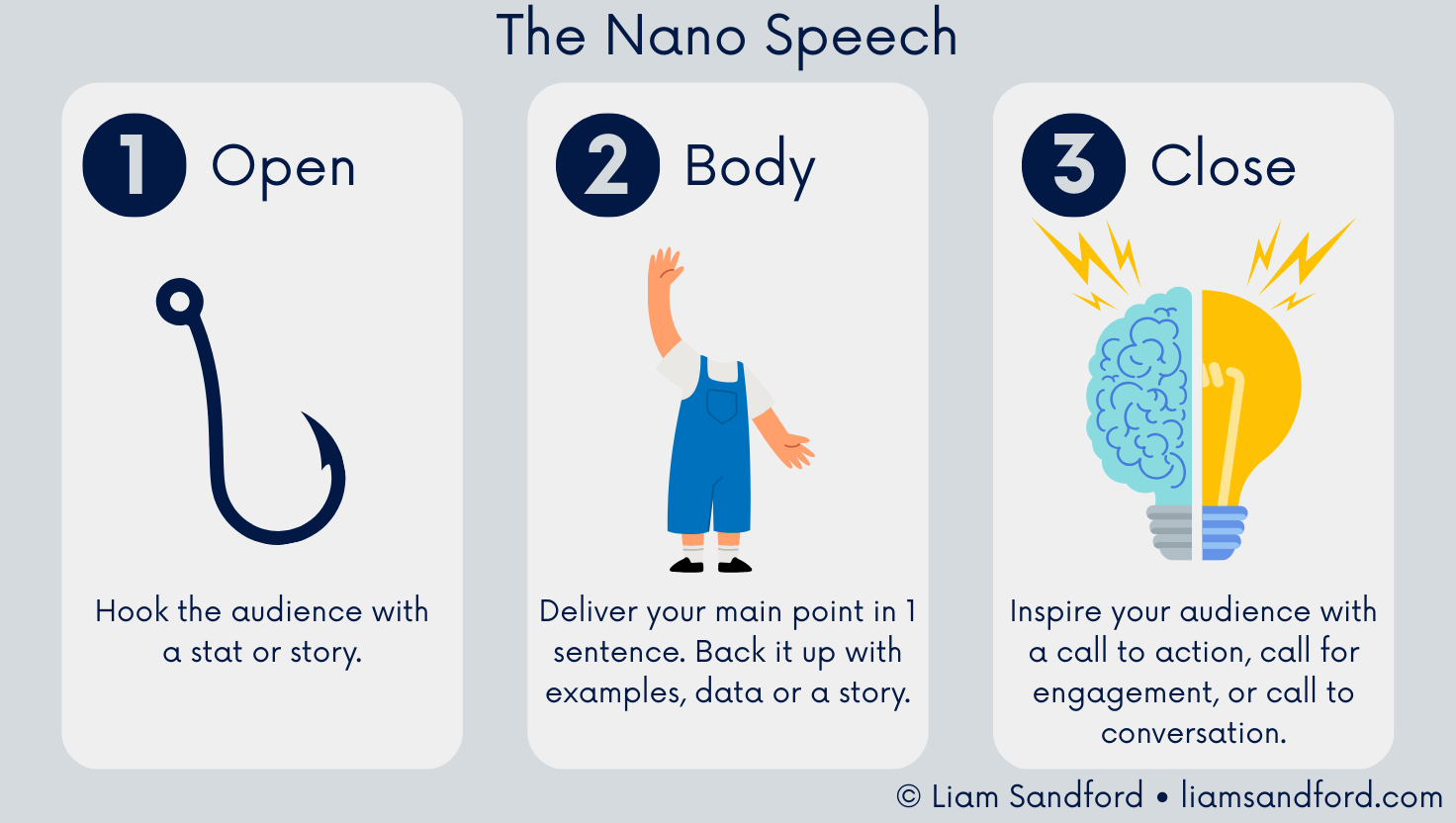How to Prepare a 10 Minute Presentation in 24 Hours: A Step by Step Guide

Liam Sandford
Liam Sandford is a public speaking coach, marketing leader, and 2x Best Selling Author, including the book Effortless Public Speaking. He helps introverted professionals and leaders take control of public speaking anxiety and use speaking to market themselves, build influence, and communicate with impact.
When you get asked to deliver a presentation with no time to prepare it can be overwhelming, but you can do it. The key is focusing on clarity, prioritization, and practical preparation. When time is tight, you need a structured approach that ensures your content is clear, your stories are engaging, and your delivery is confident. This guide walks you through every step, from defining your message to managing pressure, so you can deliver a presentation that leaves a lasting impression, even with limited preparation time. I have kept this article short, as you are short on time, but this is everything you need to deliver if you have limited time.
Start with Clarity: Define Your Core Message
Clarity is the foundation of any effective presentation. When you know exactly what you want to communicate, every decision, from what points to include to how you structure your story, becomes easier. In a time pressured situation, having a single guiding message keeps your talk focused and memorable. Without it, even well researched content can feel scattered and confusing to your audience.
Identify Your Audience and Their Needs
Understanding who you are speaking to is crucial. Even under tight deadlines, taking time to consider the audience ensures your talk is relevant and engaging. Knowing their experience level, interests, and pain points allows you to shape examples, tone, and language to match their expectations.
Determine if your audience is new to your topic or already knowledgeable.
Consider the challenges or questions they may have.
Identify what you want your audience to feel, learn, or do after your talk.
Craft a Single, Powerful Sentence
A concise core message gives your presentation direction and helps you prioritize content. This sentence becomes your anchor for all points, examples, and stories, ensuring consistency even when time is limited.
Write a single sentence that summarizes the key takeaway of your presentation.
Use it as a reference for deciding which points are essential.
Example: “Small, consistent changes in daily habits can dramatically improve focus and productivity.”
Preparing What to Say vs Preparing Slides
Many people feel pressure to perfect slides, but content always comes first. Your spoken words carry the main message, and slides should only reinforce or illustrate your points. Understanding this distinction allows you to use your time efficiently.
Focus on Your Spoken Words First
Your words are the heart of your presentation. In a short preparation window, prioritize preparing your Nano Speech, not creating slides. Planning your content first ensures you can deliver a clear, confident talk without relying on slides as a crutch.
Outline your key points with supporting examples.
Use simple, conversational language that’s easy for your audience to follow.
Include one story or anecdote per key point to make your talk memorable.
Create Slides to Enhance, Not Replace, Your Talk
Slides are a visual aid, not the main event. They should clarify or reinforce your message, not replace it. Simple, well designed slides save time and help your audience focus on what you say.
Limit text to key phrases, avoid paragraphs and bullet points on slides.
Use visuals, charts, or images to illustrate concepts quickly.
Ensure slide content matches the pace of your spoken words.
Use the Nano Speech Framework to Organize Your Talk
Structure is critical, especially when time is short. The nano speech framework, Open, Body, Close, offers a clear, easy to follow roadmap that keeps your presentation organized and engaging. Even a 10 minute talk benefits from a simple, repeatable structure.
Open: Hook Your Audience in 60 Seconds
The opening determines whether your audience will stay engaged. A strong hook immediately establishes relevance and interest.
Start with a surprising fact, statistic, or question.
Share a brief, relatable story to connect emotionally.
Clearly state the benefit of listening to your talk.
Body: Deliver Your Core Message with Impact
The body is where you communicate your main points. In a short presentation, it’s better to focus on fewer points with strong examples rather than trying to cover too much.
In a short presentation you should only have one key message. The rest is backing up that main message.
Use anecdotes, case studies, or relevant data to illustrate each point.
Provide actionable advice your audience can implement immediately.
Close: Leave a Lasting Impression
Your closing reinforces your core message and leaves your audience with something to remember. A strong ending is often more important than a perfect opening.
Summarize your key points concisely.
Refer back to your opening story or hook for cohesion.
End with a memorable takeaway or call to action.
Breaking Down Your Talk by Time
Allocating time effectively ensures your talk is balanced and prevents rushing at the end. In a 10 minute presentation, clear timing helps you cover essential content without overwhelming your audience.
Opening (1–2 minutes): Capture attention and introduce your core message.
Body (6–7 minutes): Present your main points with supporting examples and stories.
Closing (1–2 minutes): Be clear on what you are asking, or what action you want your audience to take.
Visualize your talk as three segments. Assign stories, examples, or statistics to each point, and ensure transitions flow naturally to help your audience follow your ideas effortlessly.
Crafting Stories That Stick
Stories make presentations memorable. Even in a short 10 minute talk, one or two well chosen stories can significantly enhance engagement and retention.
Choose Stories With Impact
Select stories that illustrate your points quickly and clearly. Relevance and brevity are key under time pressure.
Pick stories that directly support each main point.
Choose stories that are easy for you to recall, as you don’t have much time.
Make the story relatable by connecting it to common experiences or challenges.
Structure Stories Effectively
A simple structure ensures your stories are easy to follow and memorable.
Too much context kills attention. Keep your story moving.
Focus on actions and outcomes rather than lengthy dialogue.
Highlight emotions or stakes to make the story resonate.
Preparing Under Pressure Without Losing Focus
When time is tight, mindset and prioritization matter as much as content. Staying calm and focused allows you to prepare efficiently and confidently.
Adopt a Calm, Task Focused Mindset
A composed mindset prevents panic and helps you focus on what matters most.
Accept that perfection isn’t necessary; clarity and engagement matter more.
Break preparation into small, achievable steps.
Focus on high impact actions instead of minor details.
Prioritize Ruthlessly
Time constraints demand strict prioritization. Only include what strengthens your core message.
Identify your central idea first, everything else should support it.
If it doesn’t help your audience, don’t include it.
Choose the most relevant stories and examples for impact.
If you want to learn more on how to become a better public speaker, check out the Ultimate Guide to Public Speaking.
TL;DR: Delivering a Short, Impactful Presentation
Open Strong: Hook your audience in the first 60 seconds with a surprising fact, question, or brief relatable story, and clearly state the benefit of listening.
Body with Focus: Communicate one core message, using anecdotes, case studies, or data to illustrate points, and provide actionable takeaways.
Close Memorably: Summarize key points, tie back to your opening, and end with a clear call to action or takeaway.
Time Management: Allocate roughly 1–2 minutes for the opening, 6–7 minutes for the body, and 1–2 minutes for the close to keep your talk balanced.
Stories and Prioritization: Choose concise, relevant stories that reinforce your message, and prioritize content that directly supports your core idea for maximum impact.
More From Liam Sandford
Read my book: Effortless Public Speaking. Learn how to speak confidently, reduce stress, and turn public speaking into your competitive advantage. These actionable public speaking tips will help you improve your presentation skills for any audience.
Join the free 5-day email course: Get daily lessons packed with practical strategies to deliver effective presentations and speak confidently. This course is designed to build your public speaking skills step by step. Sign up below:
